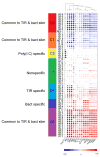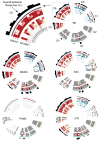A narrow repertoire of transcriptional modules responsive to pyogenic bacteria is impaired in patients carrying loss-of-function mutations in MYD88 or IRAK4
- PMID: 25344726
- PMCID: PMC4281021
- DOI: 10.1038/ni.3028
A narrow repertoire of transcriptional modules responsive to pyogenic bacteria is impaired in patients carrying loss-of-function mutations in MYD88 or IRAK4
Abstract
Loss of function of the kinase IRAK4 or the adaptor MyD88 in humans interrupts a pathway critical for pathogen sensing and ignition of inflammation. However, patients with loss-of-function mutations in the genes encoding these factors are, unexpectedly, susceptible to only a limited range of pathogens. We employed a systems approach to investigate transcriptome responses following in vitro exposure of patients' blood to agonists of Toll-like receptors (TLRs) and receptors for interleukin 1 (IL-1Rs) and to whole pathogens. Responses to purified agonists were globally abolished, but variable residual responses were present following exposure to whole pathogens. Further delineation of the latter responses identified a narrow repertoire of transcriptional programs affected by loss of MyD88 function or IRAK4 function. Our work introduces the use of a systems approach for the global assessment of innate immune responses and the characterization of human primary immunodeficiencies.
Figures







Comment in
-
Systematic analysis of immunodeficiency.Nat Immunol. 2014 Dec;15(12):1097-8. doi: 10.1038/ni.3029. Nat Immunol. 2014. PMID: 25396343
References
-
- Picard C, et al. Pyogenic bacterial infections in humans with IRAK-4 deficiency. Science. 2003;299:2076–2079. - PubMed
-
- Akira S, Uematsu S, Takeuchi O. Pathogen recognition and innate immunity. Cell. 2006;124:783–801. - PubMed
-
- Kawai T, Akira S. The role of pattern-recognition receptors in innate immunity: update on Toll-like receptors. Nat Immunol. 2010;11:373–384. - PubMed
Publication types
MeSH terms
Substances
Supplementary concepts
Associated data
- Actions
Grants and funding
LinkOut - more resources
Full Text Sources
Other Literature Sources
Molecular Biology Databases

